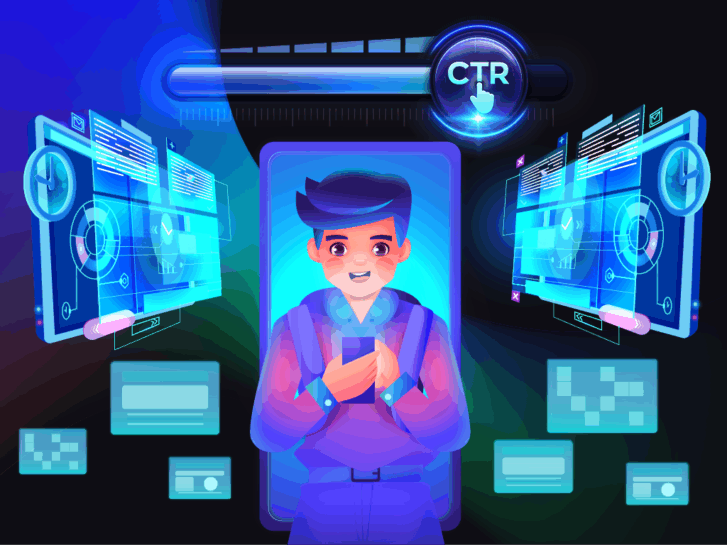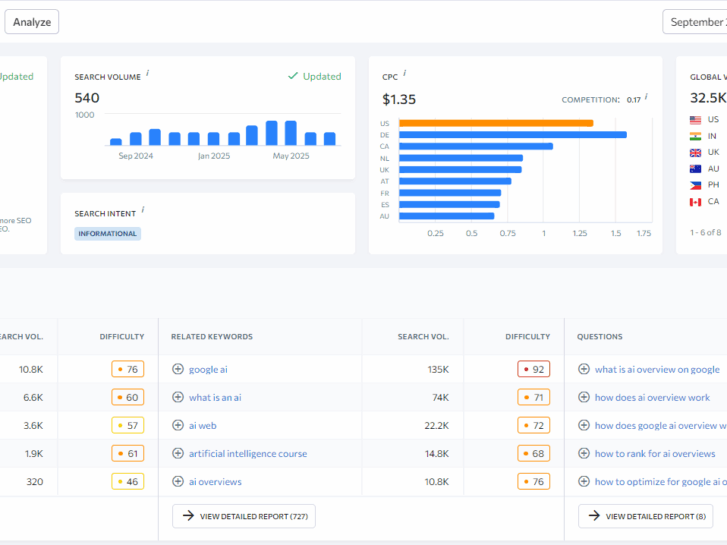Organic search has always been a fast-paced, ever-changing game, but in 2025 the rules are shifting faster than ever. With Google AI Overviews rolling out and appearing for more and more queries, SEOs and marketers face one of the biggest disruptions to visibility and CTR in recent years.
These AI-generated summaries appear prominently at the top of search results, often above organic listings, pulling information from multiple websites. While Google CEO Sundar Pichai says that they boost click-through rates (CTR) to websites they cite, the reality is clear: AI Overview impacts organic visibility, and CTRs are declining.
How Google AI Overviews Work
Google’s AI Overviews are powered by large language models (LLMs) that generate concise answers to complex queries. Here’s what makes them disruptive:
- Prominent placement – AI Overviews appear above traditional organic results, often pushing the #1 ranking further down the page.
- Summarized answers – Users get the information they need instantly (with some AIO providing information for anticipated follow-up questions), which reduces the incentive to click through.
- Inconsistent citations – While sources are sometimes cited, attribution is unclear and often buried within the summary.
- Triggered primarily by informational queries – AI Overviews show mostly on informational queries (though there are chances of seeing them for commercial and transactional keywords). These queries are the lifeblood of blogs and content-heavy sites, which now face reduced visibility.
The Impact of AI Overviews on Click-Through Rates
Research and industry data from the last year show the real-world effect of AI Overviews:
- Ahrefs: 34.5% drop in CTR for position #1 page when an AI Overview is present (April 2025).
- Amsive: Average CTR decline of 15.49% across 700,000 keywords, with drops as steep as 37% when combined with Featured Snippets (April 2025).
- MailOnline: Reported a 56% drop in CTR after AI Overviews rolled out (May 2025).
The hardest hit? Informational, non-branded keywords, where AI Overviews almost always appear.
Interestingly, branded searches are more resilient. In the same study mentioned above, Amsive found only 4.79% of branded queries triggered AI Overviews—and in those cases, CTR actually increased by 18.68%. This may mean that brand recognition helps offset potential losses in an AI-driven SERP.
Why Marketers Should Care About AI Overviews
The data is clear: AI Overviews are stealing clicks from organic search results. The implications are significant:
- Lower organic visibility and ROI – Ranking #1 doesn’t mean what it used to. Even your best-performing, top-of-page keywords may no longer deliver the same traffic or conversions.
- Murky attribution – Your content might fuel the AI Overview, but that doesn’t mean your brand gets the credit—or the clicks.
- Unclear reporting – Google Search Console doesn’t provide any AI Overview data (yet), leaving you in the dark about how much traffic (if any) they’re driving.
- Increased competition for paid search – As organic traffic declines, more brands may end up turning to Google Ads, which in turn will drive up costs.
- A bigger disruption than Featured Snippets – Like Featured Snippets before them, AI Overviews are changing search behavior. But this time, the impact is broader, deeper, and harder to work around.
Adapting Your SEO Strategy for an AI Overview World
The search landscape has changed, but it’s far from over. Here’s how marketers can adapt:
1. Top Rankings Still Matter, But They’re Not Enough
Landing in the top 8-10 spots is still important, but it’s no longer a guarantee of clicks. AI Overviews often grab attention first, so the real win is combining strong rankings with as much AI Overviews and Featured Snippet visibility as you can achieve.
2. Optimize for Featured Snippets
Featured Snippets remain highly clickable and generally easier to understand and target for most SEOs. Plus, their average CTR is a whopping 42.9% because Google only features one source, which massively increases the odds that users will click through.
Use FAQ sections, lists, concise definitions, and other content formats to increase your chances of capturing snippets.
3. Focus on High-Intent, Non-Branded Queries
Broad keywords may bring volume, but they’re also more likely to trigger AI Overviews. Instead of chasing broad, top-of-funnel keywords, target mid- to bottom-funnel search terms with clear purchase or action intent. These are less likely to trigger AI Overviews and deliver more meaningful traffic.
4. Strengthen Brand Visibility
When people search for your brand directly, AI Overviews are less of a threat. And even if your brand keywords prompt an AI Overview, you’re more than likely to be one of the cited sources in its generated answer.
Invest in optimizing your Google My Business profile, partnerships, and other brand building and awareness campaigns so users search for your brand directly, bypassing the AI layer.
5. Diversify Beyond Google
AI Overviews highlight the risk of heavily depending on Google to drive traffic. I suggest exploring alternative discovery platforms such as TikTok search, YouTube, niche forums, and even aiming to get your brand featured on answer engines such as ChatGPT or Perplexity – where answer engine optimization (AEO) will come in handy.
6. Monitor AI Overview Citations
Even if AI Overviews reduce clicks, they can still drive visibility when your content is cited. Keep an eye on which pages are being referenced, evaluate whether those mentions align with your brand positioning, and adjust your content strategy to improve the odds of being cited in future AI summaries.
While Google Search Console will not disclose impressions and clicks coming from AI Overviews where your content is cited, SEO tools like SE Ranking are adding trackers to help you monitor your visibility in this front.
Looking Ahead: The New SEO Playbook
Google claims AI Overviews generate “higher-quality clicks.” The evidence says otherwise: organic clicks are shrinking. With antitrust scrutiny looming and ad competition heating up, marketers must rethink what success in search looks like.
The future of SEO will be about more than just rankings. To thrive in an AI-driven search ecosystem, businesses must:
- Create content structured for both Featured Snippets and AI Overviews.
- Prioritize high-intent and branded queries.
- Invest in multi-channel visibility beyond Google.
- Track performance carefully and adapt quickly to CTR fluctuations.
Search is no longer just about being found on Google—it’s about being visible wherever your audience seeks answers.
That’s why my ongoing series on AEO dives deeper into how brands can adapt for visibility in answer engines like ChatGPT, Perplexity, and Gemini. You can read up in the first of the series, which covers how this generative engine era has shifted search behavior in the last year.
Key Takeaway
Google AI Overviews are impacting your CTR, and accelerating the shift toward the era zero-click search. While they reduce CTR for traditional organic results, forward-thinking SEOs and marketers can still win by adapting content strategies, doubling down on brand visibility, and diversifying traffic sources. Success in this new landscape means working towards your organic search rankings, but updating your content strategies, and building authority and trust across multiple channels.
The post AI Overviews, Zero-Click Search, and the Future of SEO appeared first on SEO Services Agency in Manila, Philippines.















